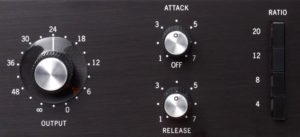- in Gear , Production , Recording by Bobby Owsinski
- |
- 5 comments
3 Critical Compressor Tweaks You Might Be Overlooking
 Everybody loves compression. It’s not only the sound of modern music, but music in general, even orchestral these days. Compression beefs up the sound, brings up the quiet parts, and controls the transients, if you use it right. That said, there are 3 compressor tweaks that are critical to optimizing the processor’s setup in order for it to work best in the track.
Everybody loves compression. It’s not only the sound of modern music, but music in general, even orchestral these days. Compression beefs up the sound, brings up the quiet parts, and controls the transients, if you use it right. That said, there are 3 compressor tweaks that are critical to optimizing the processor’s setup in order for it to work best in the track.
As it turns out, these parameters are often overlooked, as many engineers opt for either default settings or one that they tend to use in every situation. That might work in many cases, but won’t give you that little extra something that you’re probably looking from the compressor in the first place. Here are the 3 tweaks:
1. Select The Correct Compression Ratio For The Track
Of all the compression parameters, this is the one that gets overlooked the most. It’s use is actually pretty easy. If you want more punch from the track, set the Ratio control low. If you want more control, set it higher. In other words, if you want to maintain the snap of a kick or snare yet add some punch, set it at 2:1 (or even 1.5:1) so some of the transients get through. If you want to make sure that the signal more or less stays at one level, set the ratio higher, like 4:1. Some engineers love a solid bass that doesn’t dynamically move, so they’ll set the ratio at 8:1 or more (10:1 and higher is considered limiting), for instance. Once again, set the Ratio low for punch; higher for control.
2. Select The Correct Compressor Dynamics For The Track
Again, this seems to be a mystery for some, but if you set these up the right way, your entire track, not just the channel you’re working on, will feel a lot better. The idea is to get the compressor to breathe with the tempo of the song. The way you do it is to start with the Attack as slow as it will go and the Release as fast as it will go. Gradually decrease the Attack time until the high frequencies of the track begin to dull, then back it off a tad. Now increase the Release time until the sound just begins to die at the end of the beat before the next downbeat (easiest to use the snare to set this up). In other words, you’re trying to set the compressor up so it breathes with the track.
3. Make Sure The Compressor Is Actually Helping The Track
It’s really easy to think that what you’re actually doing with the compressor is helping the track when it’s louder than the original signal, but our ears are easily deceived by anything that appears louder to us. That’s why doing an A/B between the original and compressed signal at the exact same level is critical. Use the Gain control to adjust the compressed signal so it’s identical to the bypassed signal, then listen to it in the track to see if it’s actually giving you the sound that you want. After you’re happy with the sound, adjust the Gain control all you want.
These 3 compressor tweaks can make a big difference in how the processor reacts with the track. Not only will it sound better, but the entire mix will feel better with all the compressors breathing at the same tempo.
You can read more from The Mixing Engineer’s Handbook and my other books on the excerpt section of bobbyowsinski.com.

